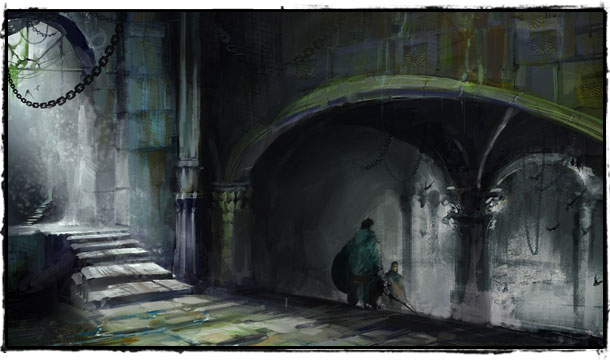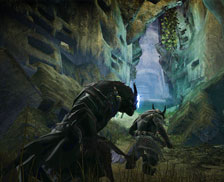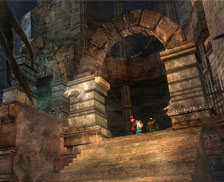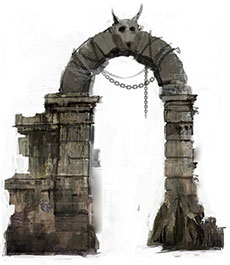Introducing Dungeons in Guild Wars 2
Night Owls Gaming Community :: Game Discussion Forums :: PC Gaming :: MMO Games :: MMO Game Forums :: Guild Wars 2 Discussions
Page 1 of 1
 Introducing Dungeons in Guild Wars 2
Introducing Dungeons in Guild Wars 2
Into the Dungeons

Hey there, Jeff Grubb here. I am, along with Ree Soesbee, one of the Lore and Continuity Designers for Guild Wars 2,
which means I am responsible for shaping the world design, maintaining
internal logic, and playing traffic cop for continuity. However, I am
also deeply engaged with our Dungeon Team—Kevin Millard, Rob Hrouda, and
Will Fairfield—in creating the stories and designs for the dungeons of
Tyria.
What Are the Dungeons?
Dungeons are multiplayer, instanced adventuring areas. Unlike
most of the rest of Tyria, which can be explored by solo players,
dungeons are designed to be played and enjoyed in pre-arranged groups,
composed of either your regular guildies or a pick-up team. Whereas our
event system creates a dynamic, ever-changing world and our personal
story allows you to weave a tale unique to your character, dungeons
represent an evolution of the original Guild Wars game experience: instanced areas with a single group of players running through them.

Calling these adventure areas "dungeons" is a bit of a misnomer,
since not all of them are underground. However, since the dungeons in Guild Wars 2 evolved from the dungeons originally presented in Guild Wars: Eye of the North,
the name pretty much stuck. They share two key traits with their
predecessors: dungeons are group activities and they are very dangerous.
At the time of this writing, we have eight dungeons in Tyria.
They are not beginner's content; the earliest of them requires
characters who've reached level 35.
Story and Explorable
When creating the dungeons, the team was faced with two
seemingly exclusive desires: we wanted to tell a story with a set
beginning, middle, and end, but we also wanted to create an instanced
area that players could return to and enjoy in multiple ways. One model
is plot-driven, while the other embraces more open, sandbox-like
gameplay, and never the twain shall meet.
But we did get them to meet.
Each of our dungeons is divided into story and explorable
versions. The story version of each dungeon comes first, and completing
it unlocks the ability to run the explorable version. In turn, the
explorable versions of the dungeons have several options (usually
three), each of which creates a different set of challenges and goals in
the game. So, when we say that there are currently eight dungeons, we
really mean there are thirty-two dungeons, as each dungeon has a story
version and three explorable versions.
The dungeon story mode tells the tale of the iconic
characters—former members of the legendary band of adventurers known as
Destiny's Edge—Zojja, Logan, Rytlock, Caithe, and Eir. At the start of
the game, each player gets to know the iconic of their race. If you are
asuran, you will cross paths with Zojja; if you are human, you will earn
the respect of Logan Thackeray. By about level 30, you are a trusted
confidant of the iconic characters, and you realize that they have their
own problems, centering on the tragic breakup of Destiny's Edge.
The backstory of these iconic heroes is told in the novel Edge
of Destiny, but it's not necessary to have read the book in order to
understand these characters as they appear in the game. As players fight
through the dungeons, they encounter each of the iconics and deal with
the repercussions of the group's breakup. Over the course of the
dungeons, players will bring the feuding members back together, a
microcosmic metaphor for the larger challenge of bringing the five main
races together to fight the Elder Dragons.
For example, in the Ascalonian dungeon, players plunge into the
catacombs beneath haunted Ascalon. The norn hero Eir Stegalkin is
hunting for the remains of King Adelbern's sword, Magdaer. The charr
tribune Rytlock Brimstone wants you to help him stop Eir before she
stirs up the restless spirits of the Ascalonian ghosts. Both you and the
iconic characters discover that there is more going on in the old
Ascalonian Catacombs than anyone had anticipated.
That tale is told and resolved in the story mode, but what of
the explorable version of this dungeon? This content happens in the same
area as the story mode, but it takes place after the events of the
story. What happens in story mode directly affects the circumstances of
the explorable mode.

As a result of your actions in the story mode, a powerful
darkness is welling up from the depths beneath the dungeon. Now the
Durmand Priory is trying to figure out how to deal with this new
problem. You and your party choose which of three approaches you'll use
to handle the threat. Each of these three options creates a different
version of the dungeon, with new areas, new challenges, and new and more
difficult creatures.
This gets back to something we've been talking about throughout our work on Guild Wars 2:
your actions have consequences. Because of what happens in story mode,
new challenges arise in explorable mode. The idea of breaking dungeons
into two mutually supporting components frees us up to tell stories, not
just about the place, but about the iconic heroes and how they come to
terms with each other. And yes, you can even run through story again, if
you so choose.
We've also brought the dynamic event system into the dungeons.
Even in story or explorable modes, the dungeon has bonus events that can
be triggered by player actions, by location, or even by random chance.
Even when you're adventuring again in the same dungeon and making the
same choices, you can get a different gaming experience as a result of
these bonus events.
Behind the Curtain: Dungeon Secrets
Breaking the dungeons into story and explorable modes allows the
designers to tailor each type of play to the needs of the players. The
story mode of a dungeon, while challenging, should be survivable by a
typical group of adventurers. The explorable mode, on the other hand, is
set up to be a challenge worthy of an organized group of experienced
players who coordinate their attacks. Given that the dungeons require
more organized, focused groups, we get to work out some truly awesome
boss battles that require teamwork and planning to overcome. There are a
number of these scripted battles in each dungeon, and some of the
bosses are truly massive in both size and power.

Dungeons are optional, but are a lot of fun for players who seek a
challenge. They don't interrupt your personal story line, but can
enhance that story line. As you get into the proper level range, your
character is made aware that a dungeon is available. Running dungeons
doesn't affect your advancement along your personal story line, and you
can reach the penultimate step in the story without setting foot in a
single dungeon instance. (That ultimate step? Well, we don't expect you
to fight an Elder Dragon all by your lonesome.)
Dungeons are geared toward a style of MMO play involving organized
groups. While a group can encounter dynamically scaling events, the
instanced nature of the dungeons creates a more tailored experience that
captures the epic nature of Guild Wars 2. If your personal
story represents your ongoing growth as a hero, the dungeons are like
chapters in an epic novel. And, of course, there's the treasure you get
from them as well.
Yes, I DID Say Treasure
Each dungeon comes with its own unique armor and weapons. The armor
from the Ascalonian dungeon is different from what you'll receive in the
dungeon of Sorrow's Embrace, which is different from the treasure found
in Lord Beetlestone's estate (remember that I said not all the dungeons
are underground). While we expect that people will encounter the story
mode once, they may run the explorable versions as many times as they
want, increasing the quantity of armor and weapons that are available
from that dungeon. Also, these armors and weapons are unique to that
particular dungeon, and will not be found elsewhere.
What Dungeons Bring to the Party (and Vice Versa)

We recognize that MMO players come in a variety of playing styles
and interests: PvP, PvE, crafters, explorers, lore hounds, social
gamers, casual players, and more. Dungeons in Guild Wars 2
reward players who enjoy organized parties and epic challenges. These
players expect not only threats that challenge well-coordinated parties,
they expect great rewards for their triumphs. The dungeons of Guild Wars 2
are rewarding to them, but also to those who want to know more about
the iconic heroes, those who relish the instanced content from the first
Guild Wars, and those who want to delve deeper into the world around them.
Welcome to the dungeons.

Hey there, Jeff Grubb here. I am, along with Ree Soesbee, one of the Lore and Continuity Designers for Guild Wars 2,
which means I am responsible for shaping the world design, maintaining
internal logic, and playing traffic cop for continuity. However, I am
also deeply engaged with our Dungeon Team—Kevin Millard, Rob Hrouda, and
Will Fairfield—in creating the stories and designs for the dungeons of
Tyria.
What Are the Dungeons?
Dungeons are multiplayer, instanced adventuring areas. Unlike
most of the rest of Tyria, which can be explored by solo players,
dungeons are designed to be played and enjoyed in pre-arranged groups,
composed of either your regular guildies or a pick-up team. Whereas our
event system creates a dynamic, ever-changing world and our personal
story allows you to weave a tale unique to your character, dungeons
represent an evolution of the original Guild Wars game experience: instanced areas with a single group of players running through them.

Calling these adventure areas "dungeons" is a bit of a misnomer,
since not all of them are underground. However, since the dungeons in Guild Wars 2 evolved from the dungeons originally presented in Guild Wars: Eye of the North,
the name pretty much stuck. They share two key traits with their
predecessors: dungeons are group activities and they are very dangerous.
At the time of this writing, we have eight dungeons in Tyria.
They are not beginner's content; the earliest of them requires
characters who've reached level 35.
Story and Explorable
When creating the dungeons, the team was faced with two
seemingly exclusive desires: we wanted to tell a story with a set
beginning, middle, and end, but we also wanted to create an instanced
area that players could return to and enjoy in multiple ways. One model
is plot-driven, while the other embraces more open, sandbox-like
gameplay, and never the twain shall meet.
But we did get them to meet.
Each of our dungeons is divided into story and explorable
versions. The story version of each dungeon comes first, and completing
it unlocks the ability to run the explorable version. In turn, the
explorable versions of the dungeons have several options (usually
three), each of which creates a different set of challenges and goals in
the game. So, when we say that there are currently eight dungeons, we
really mean there are thirty-two dungeons, as each dungeon has a story
version and three explorable versions.
The dungeon story mode tells the tale of the iconic
characters—former members of the legendary band of adventurers known as
Destiny's Edge—Zojja, Logan, Rytlock, Caithe, and Eir. At the start of
the game, each player gets to know the iconic of their race. If you are
asuran, you will cross paths with Zojja; if you are human, you will earn
the respect of Logan Thackeray. By about level 30, you are a trusted
confidant of the iconic characters, and you realize that they have their
own problems, centering on the tragic breakup of Destiny's Edge.
The backstory of these iconic heroes is told in the novel Edge
of Destiny, but it's not necessary to have read the book in order to
understand these characters as they appear in the game. As players fight
through the dungeons, they encounter each of the iconics and deal with
the repercussions of the group's breakup. Over the course of the
dungeons, players will bring the feuding members back together, a
microcosmic metaphor for the larger challenge of bringing the five main
races together to fight the Elder Dragons.
For example, in the Ascalonian dungeon, players plunge into the
catacombs beneath haunted Ascalon. The norn hero Eir Stegalkin is
hunting for the remains of King Adelbern's sword, Magdaer. The charr
tribune Rytlock Brimstone wants you to help him stop Eir before she
stirs up the restless spirits of the Ascalonian ghosts. Both you and the
iconic characters discover that there is more going on in the old
Ascalonian Catacombs than anyone had anticipated.
That tale is told and resolved in the story mode, but what of
the explorable version of this dungeon? This content happens in the same
area as the story mode, but it takes place after the events of the
story. What happens in story mode directly affects the circumstances of
the explorable mode.

As a result of your actions in the story mode, a powerful
darkness is welling up from the depths beneath the dungeon. Now the
Durmand Priory is trying to figure out how to deal with this new
problem. You and your party choose which of three approaches you'll use
to handle the threat. Each of these three options creates a different
version of the dungeon, with new areas, new challenges, and new and more
difficult creatures.
This gets back to something we've been talking about throughout our work on Guild Wars 2:
your actions have consequences. Because of what happens in story mode,
new challenges arise in explorable mode. The idea of breaking dungeons
into two mutually supporting components frees us up to tell stories, not
just about the place, but about the iconic heroes and how they come to
terms with each other. And yes, you can even run through story again, if
you so choose.
We've also brought the dynamic event system into the dungeons.
Even in story or explorable modes, the dungeon has bonus events that can
be triggered by player actions, by location, or even by random chance.
Even when you're adventuring again in the same dungeon and making the
same choices, you can get a different gaming experience as a result of
these bonus events.
Behind the Curtain: Dungeon Secrets
Breaking the dungeons into story and explorable modes allows the
designers to tailor each type of play to the needs of the players. The
story mode of a dungeon, while challenging, should be survivable by a
typical group of adventurers. The explorable mode, on the other hand, is
set up to be a challenge worthy of an organized group of experienced
players who coordinate their attacks. Given that the dungeons require
more organized, focused groups, we get to work out some truly awesome
boss battles that require teamwork and planning to overcome. There are a
number of these scripted battles in each dungeon, and some of the
bosses are truly massive in both size and power.

Dungeons are optional, but are a lot of fun for players who seek a
challenge. They don't interrupt your personal story line, but can
enhance that story line. As you get into the proper level range, your
character is made aware that a dungeon is available. Running dungeons
doesn't affect your advancement along your personal story line, and you
can reach the penultimate step in the story without setting foot in a
single dungeon instance. (That ultimate step? Well, we don't expect you
to fight an Elder Dragon all by your lonesome.)
Dungeons are geared toward a style of MMO play involving organized
groups. While a group can encounter dynamically scaling events, the
instanced nature of the dungeons creates a more tailored experience that
captures the epic nature of Guild Wars 2. If your personal
story represents your ongoing growth as a hero, the dungeons are like
chapters in an epic novel. And, of course, there's the treasure you get
from them as well.
Yes, I DID Say Treasure
Each dungeon comes with its own unique armor and weapons. The armor
from the Ascalonian dungeon is different from what you'll receive in the
dungeon of Sorrow's Embrace, which is different from the treasure found
in Lord Beetlestone's estate (remember that I said not all the dungeons
are underground). While we expect that people will encounter the story
mode once, they may run the explorable versions as many times as they
want, increasing the quantity of armor and weapons that are available
from that dungeon. Also, these armors and weapons are unique to that
particular dungeon, and will not be found elsewhere.
What Dungeons Bring to the Party (and Vice Versa)

We recognize that MMO players come in a variety of playing styles
and interests: PvP, PvE, crafters, explorers, lore hounds, social
gamers, casual players, and more. Dungeons in Guild Wars 2
reward players who enjoy organized parties and epic challenges. These
players expect not only threats that challenge well-coordinated parties,
they expect great rewards for their triumphs. The dungeons of Guild Wars 2
are rewarding to them, but also to those who want to know more about
the iconic heroes, those who relish the instanced content from the first
Guild Wars, and those who want to delve deeper into the world around them.
Welcome to the dungeons.

Chief War- NOG Senior Member

- Posts : 145
Join date : 2011-06-23
Location : Washington
Age : 34
 Similar topics
Similar topics» Guild Wars 2 - Sparkfly Fen
» Guild Wars 2 Info
» Guild Wars 2 - Melee Gameplay
» Guild Wars 2 - Boss Battle
» Guild Wars 2 Manifesto Trailer [HD]
» Guild Wars 2 Info
» Guild Wars 2 - Melee Gameplay
» Guild Wars 2 - Boss Battle
» Guild Wars 2 Manifesto Trailer [HD]
Night Owls Gaming Community :: Game Discussion Forums :: PC Gaming :: MMO Games :: MMO Game Forums :: Guild Wars 2 Discussions
Page 1 of 1
Permissions in this forum:
You cannot reply to topics in this forum